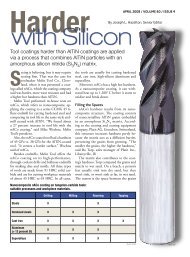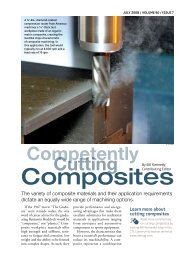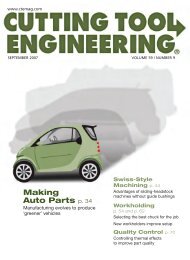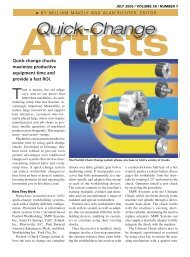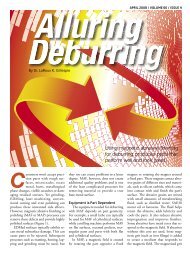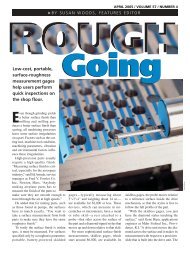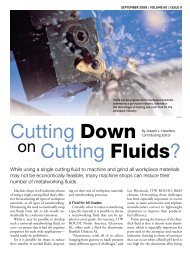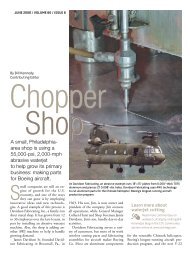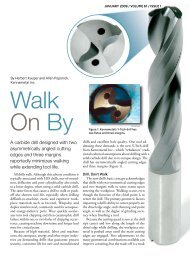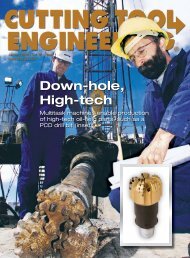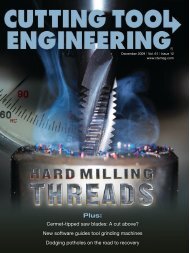Toolmakers offer productive, application-focused ways to enlarge ...
Toolmakers offer productive, application-focused ways to enlarge ...
Toolmakers offer productive, application-focused ways to enlarge ...
Create successful ePaper yourself
Turn your PDF publications into a flip-book with our unique Google optimized e-Paper software.
B. Kennedy<br />
➤ B Y B i l l k e n n e d Y, c o n t r i B u t i n g e d i t o r<br />
Bigg<br />
andBetter <strong>Toolmakers</strong><br />
JANUARY 2008 / VOLUME 60 / NUMBER 1<br />
<strong>offer</strong><br />
<strong>productive</strong>,<br />
<strong>application</strong>-<strong>focused</strong><br />
<strong>ways</strong> <strong>to</strong> <strong>enlarge</strong><br />
existing holes.<br />
Holemaking is the most<br />
common metalworking<br />
operation, so it follows<br />
that holemaking is frequently<br />
the focus of productivity improvement<br />
efforts. An obvious<br />
way <strong>to</strong> cut costs and speed<br />
throughput when making holes<br />
is <strong>to</strong> remove a lot of material<br />
in a hurry. This article covers<br />
selected <strong>to</strong>ol <strong>offer</strong>ings and <strong>application</strong><br />
recommendations developed<br />
<strong>to</strong> match shop needs<br />
when it comes <strong>to</strong> enlarging existing<br />
holes.<br />
Many Parts, Little Time<br />
For some shops, maximizing<br />
speed and quality is the<br />
primary goal. Removing material<br />
fast and reducing cycle<br />
times are especially crucial in<br />
the high-volume arena of au<strong>to</strong>motive<br />
manufacturing. Powers<br />
The Opening Drill line of holeenlarging<br />
<strong>to</strong>ols from Allied<br />
Machine & Engineering removes<br />
a large amount of material<br />
quickly with relatively low<br />
cutting forces and minimal stress<br />
on the machine <strong>to</strong>ol.
and Sons LLC, Montpelier, Ohio, is<br />
a designer and manufacturer of steering<br />
and suspension components, systems<br />
and assemblies. The company<br />
machines forged steel parts primarily<br />
for trucks, including Ford 150 <strong>to</strong> 550<br />
models and vehicles from Chrysler,<br />
General Mo<strong>to</strong>rs, Volvo and International<br />
Truck. “We don’t have many<br />
jobs that are 5,000 pieces,” said Michael<br />
Manon, manufacturing engineer<br />
for Powers and Sons. “We are talking<br />
hundreds of thousands of pieces, most<br />
produced in two-shift operations. Certain<br />
areas are running three shifts.” In a<br />
true understatement, he added, “In our<br />
business, cycle time is important.”<br />
Powers and Sons spends a good deal<br />
of time enlarging holes. “They may be<br />
forged holes that we are going in<strong>to</strong> <strong>to</strong><br />
remove a lot of material, or they may<br />
be solid forgings that we have <strong>to</strong> drill<br />
Powers and Sons<br />
through, then go in from the opposite<br />
side <strong>to</strong> open up,” Manon said. The<br />
parts are primarily made of 1040 steel,<br />
but 1541 hardened material (242 <strong>to</strong><br />
284 HB) is used in <strong>application</strong>s that<br />
require more strength. After roughing,<br />
the holes usually are finish bored <strong>to</strong><br />
<strong>to</strong>lerances of 0.004" or tighter.<br />
To <strong>enlarge</strong> the holes, Manon applies<br />
fixed-pocket inserted Coremaster<br />
core drills from Manchester Tool Co.’s<br />
OTM division, Wapakoneta, Ohio. The<br />
drills are <strong>offer</strong>ed in nine diameters,<br />
from 0.825" <strong>to</strong> 1.303". The larger-<br />
Powers and Sons uses CD 938<br />
Coremaster core drills from OTM <strong>to</strong> open<br />
up 10.63mm- <strong>to</strong> 12.09mm-dia. cored<br />
holes (right) in forged and heat-treated<br />
1541 steel idler arms. In a single pass,<br />
the drill takes the holes <strong>to</strong> within 0.5mm<br />
of finish size. The final diameter of<br />
24.49mm, ±0.03mm (left), is then bored.<br />
diameter drills can remove as much<br />
as 3 ⁄8" of material per side. OTM also<br />
<strong>offer</strong>s 17 adjustable-cartridge Coremaster<br />
drills in diameters from 1.36"<br />
<strong>to</strong> 3.06". Cartridges can be adjusted up<br />
<strong>to</strong> 0.075" per side, providing 0.150"<br />
adjustment capability on diameter.<br />
Powers and Sons employs the <strong>to</strong>ols<br />
for roughing. “We have <strong>to</strong> remove a<br />
couple hundred thousandths on a side<br />
of a bore,” Manon said. “We rough<br />
it out, get it out of the way; we don’t<br />
really gage a dimension off it. We<br />
need <strong>to</strong> get in and out of the hole as<br />
fast as possible.” As a result, the drill<br />
manufacturer’s <strong>application</strong> parameter<br />
recommendations represent a starting<br />
point. “We will challenge the <strong>to</strong>ol,”<br />
Manon said. “We need <strong>to</strong> find out how<br />
fast the <strong>to</strong>ol can get it done.” He added<br />
that the hardened 1541 alloy parts usually<br />
require about a 30 percent reduc-<br />
tion in cutting speed compared <strong>to</strong> those<br />
made with 1040 alloys.<br />
However, machining speed must be<br />
balanced against <strong>to</strong>ol life. “We’ve got<br />
<strong>to</strong> be able <strong>to</strong> maintain <strong>to</strong>ol life and cost<br />
per piece. I can’t sacrifice high dollars<br />
in <strong>to</strong>ol costs for cycle times in machining,”<br />
he said.<br />
The <strong>to</strong>ols enable Powers and Sons<br />
<strong>to</strong> remove “extra material that we can’t<br />
take out unless we use several other<br />
<strong>to</strong>ols. You’d have more <strong>to</strong>ol changes,<br />
less cut time and higher <strong>to</strong>ol cycle<br />
times,” Manon said.<br />
Bob Erickson, an OTM engineer,<br />
pointed out that the two-insert design<br />
of the <strong>to</strong>ols enable them <strong>to</strong> correct<br />
holes that are out of position because<br />
of the vagaries of the forging or casting<br />
process. Unlike boring bars, the twoinsert<br />
design of the <strong>to</strong>ols is “2-flutes effective,”<br />
Erickson said. “It’s not going<br />
<strong>to</strong> follow the hole; instead, it’s going<br />
<strong>to</strong> drill in a straight line. If the hole is<br />
0.060" from where it ought <strong>to</strong> be, the<br />
core drill doesn’t care—it puts the hole<br />
in the right spot.”<br />
In that case, drill alignment determines<br />
hole position. “When you fix-<br />
A core drill can be<br />
a semifinishing or a<br />
finishing <strong>to</strong>ol, depending<br />
on the <strong>to</strong>lerance.<br />
ture the part, you fixture on the locating<br />
edges. If the hole should be 2" over<br />
and 3" the other way, that’s where you<br />
put your hole,” Erickson said.<br />
He added that because the core drills<br />
have two effective flutes, they operate<br />
at two times the feed rate of inserted<br />
drills. The relevant formula is feed<br />
(ipr) = fpt × effective flutes. For example,<br />
he said, “If you feed 0.008 ipr<br />
with an inserted drill, you’d feed 0.016<br />
ipr with a core drill.” Erickson said a<br />
core drill can be a semifinishing or a<br />
finishing <strong>to</strong>ol, depending on the <strong>to</strong>lerance.<br />
“When you are talking tenths,<br />
no,” he said, “but if you are talking a<br />
few thousandths, a core drill is a fine<br />
finishing <strong>to</strong>ol.”<br />
Larger Holes, Less Stress<br />
Other shops’ choice of hole-enlarging<br />
<strong>to</strong>ols may be based at least partly<br />
on the economic realities of their<br />
particular situations. Although many<br />
manufacturing sec<strong>to</strong>rs are booming,<br />
a cloudy economic outlook and competitive<br />
pressures are causing some<br />
shops—especially smaller ones—<strong>to</strong><br />
be cautious in their outlays for capital<br />
equipment. As a result, many shops<br />
face un<strong>productive</strong> alternatives when<br />
it comes time <strong>to</strong> make larger diameter<br />
holes, said Rob Brown, product<br />
manager for holemaking and grinding<br />
products supplier Allied Machine &<br />
Engineering Corp. (AMEC), Dover,<br />
Ohio. “They have a 15-hp machine and<br />
have a job <strong>to</strong> drill a 3½"-dia. hole,” he<br />
said. “That machine is not designed<br />
<strong>to</strong> do that kind of work. To do a largediameter<br />
hole on a light-duty machine,
you have <strong>to</strong> do pass after pass <strong>to</strong> get it<br />
<strong>to</strong> your finished size.” A number of ascending-diameter<br />
drills or boring bars<br />
would be required.<br />
Through an exclusive supply agreement<br />
with <strong>to</strong>olmaker VMaxx Inc.,<br />
Wapakoneta, Ohio, AMEC introduced<br />
its Opening Drill line of holeenlarging<br />
<strong>to</strong>ols. The drills feature twin,<br />
opposing adjustable cartridges that can<br />
be positioned <strong>to</strong> create an overlapping<br />
cut and <strong>enlarge</strong> a hole in one pass.<br />
Brown said the <strong>to</strong>ols remove a large<br />
amount of material quickly with relatively<br />
low cutting forces and minimal<br />
stress on the machine <strong>to</strong>ol. “You are<br />
not doing fine work here; you are trying<br />
<strong>to</strong> just blow the hole open and then<br />
do your finish pass. It’s going <strong>to</strong> reduce<br />
the number of steps required <strong>to</strong> get <strong>to</strong><br />
the finished size.”<br />
The <strong>to</strong>ols also permit <strong>enlarge</strong>ment<br />
of irregular holes in castings. “The<br />
<strong>to</strong>oling can handle a core shift of up<br />
<strong>to</strong> 1 ⁄8". The geometry of the insert<br />
and the holder enables the <strong>to</strong>ol <strong>to</strong> ignore<br />
where the pre-existing hole is,”<br />
Brown said.<br />
As with all drilling <strong>application</strong>s,<br />
<strong>to</strong>ol alignment is crucial. According <strong>to</strong><br />
AMEC, an Opening Drill in a stationary<br />
<strong>application</strong>, such as on a lathe,<br />
must be on center with the part within<br />
0.015" TIR. Also, AMEC strongly<br />
suggests that the turret pod be indicated<br />
relative <strong>to</strong> the chuck before <strong>to</strong>ol<br />
mounting. Applications on a machining<br />
center will typically be self-centering,<br />
but AMEC recommends TIR be<br />
within 0.005".<br />
Brown said the adjustability of the<br />
AMEC <strong>to</strong>ols makes them adaptable<br />
<strong>to</strong> a variety of parts, a capability that<br />
is important for a job shop. “It’s not<br />
specific <strong>to</strong> one particular job. It allows<br />
you <strong>to</strong> do many different things with<br />
one <strong>to</strong>ol body.”<br />
Removable cartridges also help protect<br />
the investment in the <strong>to</strong>ol body in<br />
the event of a crash. Four <strong>to</strong>ol bodies<br />
cover diameters from 2.00" <strong>to</strong> 5.62".<br />
Because the <strong>to</strong>ols open existing<br />
holes, not start them, a pilot (starter)<br />
hole of a minimum diameter is required.<br />
“This is a coring <strong>to</strong>ol, so it’s<br />
not center cutting,” Brown said. The<br />
minimum pilot diameter is specific <strong>to</strong><br />
BIG Kaiser<br />
<strong>to</strong>ol size, determined by the smallest<br />
diameter <strong>to</strong> which the two cartridges<br />
can be set. Minimum pilot diameter for<br />
the three smaller <strong>to</strong>ol bodies is 1.880"<br />
under the finish hole size, while the<br />
largest <strong>to</strong>ol can start with a minimum<br />
pilot diameter of 2.680" under the finish<br />
hole size. For example, creating<br />
The Opening Drill line<br />
of hole-enlarging <strong>to</strong>ols<br />
feature twin, opposing<br />
adjustable cartridges that<br />
can be positioned <strong>to</strong> create<br />
an overlapping cut and<br />
<strong>enlarge</strong> a large-diameter<br />
hole in one pass on a<br />
light-duty machine.<br />
a 2.5"-dia. hole would require a pilot<br />
hole of at least 0.620" in diameter,<br />
while creating a 5.62"-dia. hole would<br />
require a starter hole with a minimum<br />
diameter of 2.94".<br />
When the <strong>to</strong>ols are in use, one cartridge<br />
is adjusted <strong>to</strong> a specific diameter<br />
and the other is adjusted, or “phased,”<br />
<strong>to</strong> a 0.160" <strong>to</strong> 0.200" smaller radius.<br />
The phasing on the inboard cartridge<br />
does not require high accuracy and<br />
anything in the 0.160" <strong>to</strong> 0.200" range<br />
is acceptable. Within that range, phase<br />
can be manipulated <strong>to</strong> help balance the<br />
cut. However, the overlap must not be<br />
less than 0.040" <strong>to</strong> ensure that it covers<br />
the noncutting area between the inserts.<br />
The <strong>to</strong>ols can be applied for roughing<br />
and some finishing operations.<br />
Brown provided an example of the<br />
<strong>to</strong>ols’ capability <strong>to</strong> <strong>enlarge</strong> and finish<br />
existing holes. An au<strong>to</strong>motive components<br />
manufacturer was performing<br />
a multiple-step operation <strong>to</strong> <strong>enlarge</strong><br />
holes in s<strong>to</strong>ck part blanks. Typically,<br />
a 6"-thick, free-machining steel blank<br />
had a 1.5"-dia. existing hole. To <strong>enlarge</strong><br />
the hole <strong>to</strong> a required diameter<br />
of 3.100", the shop used a core drill <strong>to</strong><br />
open the hole <strong>to</strong> a 2.0" diameter and<br />
then <strong>to</strong>ok 10 or 11 passes with a boring<br />
bar <strong>to</strong> reach the final size. To speed<br />
throughput, an AMEC OP2 Opening<br />
Drill was adjusted <strong>to</strong> produce a 3.00"dia.<br />
hole run at 500 sfm and 0.005<br />
ipr. The <strong>to</strong>ol <strong>to</strong>ok<br />
the diameter from<br />
1.5" <strong>to</strong> 3.00" in<br />
a single pass.<br />
BIG Kaiser<br />
Twin-cutter boring heads from<br />
BIG Kaiser provide three different<br />
approaches <strong>to</strong> rough and semifinish<br />
existing holes: balanced cutting (left),<br />
stepped cutting (center) and full-profile<br />
cutting (right). In that order, each<br />
method can remove larger amounts of<br />
s<strong>to</strong>ck, but must operate at successively<br />
lower feed rates.<br />
After being adjusted <strong>to</strong> remove 0.050"<br />
per side in a boring operation, the<br />
Opening Drill, run at 400 sfm and<br />
0.005 ipr, produced the final bore dimension<br />
with a finish of approximately<br />
50µin. R a .<br />
Triple-Option Twin-Bore<br />
The just-in-time nature of much of<br />
<strong>to</strong>day’s manufacturing drives many<br />
shops <strong>to</strong> emphasize flexibility and adjustability<br />
in their <strong>to</strong>oling systems for<br />
enlarging holes. “Essentially, any drill<br />
can <strong>enlarge</strong> a hole,” said John Zaya,<br />
<strong>application</strong>s engineer at BIG Kaiser<br />
Precision Tooling Inc., Elk Grove Village,<br />
Ill., “Boring allows you <strong>to</strong> have<br />
adjustability in the diameter you are<br />
cutting. That’s the main difference<br />
between drilling and boring.”<br />
BIG Kaiser manufactures a series<br />
of twin-cutter boring heads <strong>to</strong> rough<br />
and semifinish existing holes. Series<br />
314 and 315 heads cover holes<br />
ranging from 0.787" <strong>to</strong> 8.000". The<br />
Series 315 rough boring heads from BIG<br />
Kaiser feature two 180°-opposed inserts<br />
that are adjustable for radial diameter<br />
and axial height.
heads feature two 180°-opposed inserts<br />
that are adjustable for radial diameter<br />
and axial height.<br />
The heads provide three different<br />
approaches <strong>to</strong> roughing existing holes.<br />
In balanced cutting, both inserts are set<br />
at the same radial diameter and axial<br />
height. This arrangement produces<br />
maximum concentricity and permits<br />
higher feed rates because the setup has<br />
two effective flutes.<br />
In a second approach, step cutting,<br />
one insert is set <strong>to</strong> a larger radial diameter<br />
while the other is set <strong>to</strong> a deeper<br />
axial depth. The deeper axial depth<br />
means the insert is slightly ahead of<br />
the other insert. Step cutting provides<br />
higher cutting capacity and can handle<br />
a larger s<strong>to</strong>ck allowance than balanced<br />
cutting, but a reduction in feed rate is<br />
required because the setup is 1-flute<br />
effective.<br />
Zaya compared the ability of balanced<br />
and step cutting methods <strong>to</strong><br />
handle s<strong>to</strong>ck allowance. It’s possible <strong>to</strong><br />
B. Kennedy<br />
Allied Machine &<br />
Engineering Corp.<br />
(800) 321-5537<br />
www.alliedmachine.com<br />
BIG Kaiser Precision<br />
Tooling Inc.<br />
(888) 866-5776<br />
www.bigkaiser.com<br />
Allied Machine &<br />
Engineering product<br />
manager Rob<br />
Brown (left) and<br />
R&D test engineer<br />
Bradley Gray discuss<br />
<strong>application</strong> testing<br />
of Opening Drill<br />
hole-enlarging<br />
<strong>to</strong>ols.<br />
The following companies<br />
contributed <strong>to</strong> this report:<br />
OTM Div. of Manchester<br />
Tools Co.<br />
(800) 237-8787<br />
www.manchester<strong>to</strong>ols.com<br />
Powers and Sons LLC<br />
(419) 485-3151<br />
www.powersandsonsllc.com
emove up <strong>to</strong> 0.300" on diameter when<br />
employing balanced cutting using a<br />
3 ⁄8" inscribed-circle CC09, diamondshaped<br />
insert <strong>to</strong> <strong>enlarge</strong> a hole in 1020<br />
steel. Using step cutting, s<strong>to</strong>ck allow-<br />
ance increases <strong>to</strong> 0.500". Applying<br />
a ½"-IC insert in the same material,<br />
0.400" s<strong>to</strong>ck removal achieved in<br />
balanced cutting can be increased <strong>to</strong><br />
0.800" when step cutting.<br />
Balanced and step cutting employ<br />
triangular, diamond or square inserts.<br />
Full profile cutting, the third roughboring<br />
approach possible with the<br />
heads, uses trigon inserts—a triangle<br />
with an intermediate angle on each<br />
side. The cutting edge configuration<br />
gives the <strong>to</strong>ol four cutting profiles,<br />
enabling the removal of large s<strong>to</strong>ck allowances<br />
in a single pass.<br />
Comparing all three hole-enlarging<br />
methods, balanced cutting permits<br />
s<strong>to</strong>ck removal up <strong>to</strong> 10 percent of the<br />
final bore diameter. With step cutting,<br />
the percentage increases up <strong>to</strong> 20 percent.<br />
With profile cutting, the increase<br />
doubles again—up <strong>to</strong> 40 percent of the<br />
final bore diameter. Like step cutting,<br />
‘Boring allows you <strong>to</strong><br />
have adjustability in the<br />
diameter you are cutting.<br />
That’s the main difference<br />
between drilling and<br />
boring.’<br />
profile cutting also is 1-flute effective<br />
in relation <strong>to</strong> feed rates.<br />
Hole finish depends on many variables,<br />
including the material, fixturing,<br />
machine, spindle, age of the machine<br />
and spindle combination and <strong>to</strong>ol cleanliness.<br />
“If you had a brand new machine<br />
with a great fixture and a brand new<br />
<strong>to</strong>ol, you could probably achieve surface<br />
finish upwards of 60 <strong>to</strong> 70µin. R a<br />
with just a roughing pass,” Zaya said.<br />
That will be sufficient for many users,<br />
while others will complete the hole<br />
with a fine-finishing operation.<br />
Assuming a rigid machine, <strong>to</strong>olholder<br />
and workpiece combination,<br />
BIG Kaiser said its twin cutters can<br />
maintain repeatability of bore size<br />
within 0.0002", location and roundness<br />
within 0.0005" and bore <strong>to</strong>lerance<br />
0.004" when a <strong>to</strong>ol presetter is<br />
employed. q<br />
CUTTING TOOL ENGINEERING Magazine is protected under U.S. and international copyright laws.<br />
Before reproducing anything from this Web site, call the Copyright Clearance Center Inc. at (978) 750-8400.



